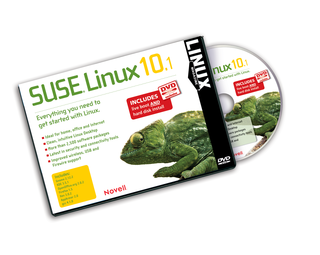
Since August of 2005, Novell has worked steadily to transform the beloved Suse Linux from a shrink-wrapped consumer product to a true community distribution. Suse Linux 10.0 marked the start of this new era. And after several months of steady work, Suse Linux 10.1 has finally appeared. Novell calls Suse Linux 10.1 "... the first version of Suse Linux created in full partnership with the open source community." Suse Linux 10.1 is a desktop distro with plenty of power for the professional.
Suse Linux 10.1 comes with Linux kernel 2.6.16. Also included are the KDE 3.5.1 and Gnome 2.12.2 desktops, along with hundreds of tools for developers, system admins, and desktop users. This release includes improvements to the Xen virtualization tool and provides, for the first time, the AppArmor application security system, Novell's equivalent to SELinux.
One of the most important improvements with Suse Linux 10.1 is the innovative Xgl graphics system. Xgl and the accompanying Compiz composite manager provide an OpenGL interface for the Suse Linux desktop. The Xgl interface delivers faster graphics and helps desktop applications make more efficient use of vendor-specific hardware enhancements.
On this DVD, you'll find favorite office tools such as OpenOffice 2.0 and Mozilla Firefox 1.5. Also included is the Beagle desktop search utility, as well as a large collection of games and educational tools. Suse Linux 10.1 also offers improved support for portables and a large collection of multimedia tools.
Suse supports a broad collection of tools for the server room, including standard Linux servers such as Apache, CUPS, Samba, Sendmail, and Bind. System administrators will also find a useful collection of utilities for system monitoring and remote management.
Novell's vision for a community-based Linux distro comes to fruition with Suse Linux 10.1. This DVD delivers great graphics, as well as new tools and improvements to the components you've come to expect from Suse. The live install option lets you try out Suse Linux 10.1 without altering the contents of your hard drive. We hope you enjoy this month's Linux Magazine Suse Linux 10.1 DVD.
| Installation Tip |
|
When you boot this DVD on a machine with less than 512 MB RAM, you'll encounter the error message "Sorry, but SUSE Linux 10.1 LiveCD needs at least 512MB main memory." The LIVE system won't run with less than 512 MB, but you can still perform a hard disk install:
The system will start; you will return to graphics mode once the installer is loaded. |
| System Requirements |
|
Processor: Pentium 1-4 or equivalent. Memory: At least 512 MB. Hard Disk: At least 500 MB for a minimal system; 2.5 GB recommended for a standard system. |
| Help & Support |
|
See http://support.novell.com/forums/2su.html for a summary of Novell-sponsored support forums for Suse Linux. See also the Suse Forums website, http://www.suseforums.net/. The OpenSuse.org project maintains its own Help resources, including the OpenSuse support database, http://en.opensuse.org/SDB:SDB, and the OpenSuse documentation page, http://en.opensuse.org/Documentation. |
| Highlights |
|
Linux kernel 2.6.16 KDE 3.5.1 GNOME 2.12.2 GCC 4.1.0 OpenOffice 2.0.2 KOffice 1.4.2 GIMP 2.2.10 Firefox 1.5 Thunderbird 1.5 AmaroK 1.3.8 Kaffeine 0.7.1 Banshee 0.10 RealPlayer 10.0.7 K3b 0.12.14 Apache 2.2.0 Bind 9.3.2 Samba 3.0.22 Sendmail 8.13.6 Perl 5.8.8 Python 2.4.2 Xen 3.0.2 AppArmor 2.0 |
| Additional Resources |
|
[1] OpenSuse project: http://www.opensuse.org [2] Bug reports: http://en.opensuse.org/Submitting_Bug_Reports [3] Novell documentation: http://www.novell.com/documentation |